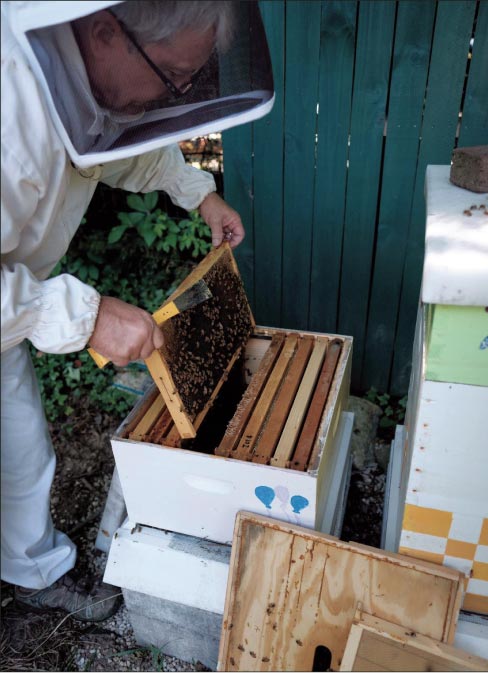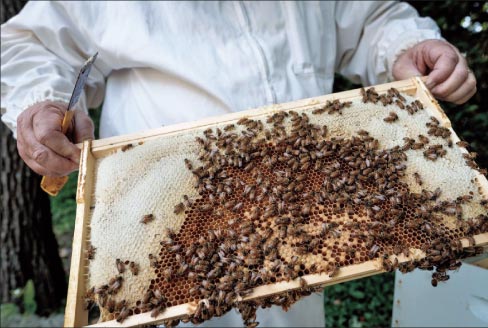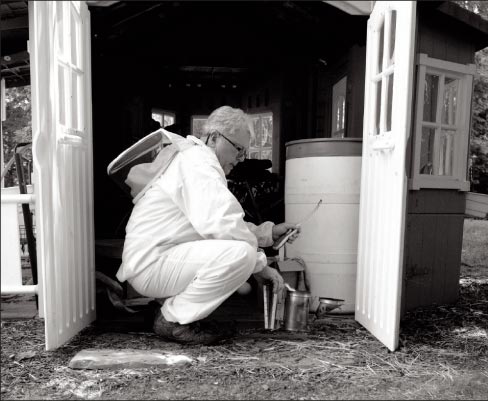Stone Restoration and Maintenance Corner: Bob’s Honey Bees
Bob Murrell
M3 Technologies
Photos provided by Bob Murrell
We all need an occasional break from our careers to relax and unwind. This month, I am going to take a break from the inorganic things (rocks) I normally discuss to tell you about some interesting (to me) organic things. The organic things I will be writing about in this article are honey bees, specifically Apis mellifera.
 |
|
Above, Left: A typical urban apiary. Above, Right: Inspecting a honey super frame. The comb is drawn but not full of honey yet. |
 |
|
Above: Inspecting the Super. I didn’t find the queen on this inspection, but did find plenty of evidence she is there. Eggs, larvae, and pupae all indicate a good healthy queen. Yes, I am doing this without hand protection! |
 |
|
Above: Great brood pattern here. Notice the rainbow or arching pattern. Capped brood in middle bottom. Eggs and larvae are in surrounding brownish area. Then all is surrounded by capped honey (white area) to feed the quickly growing bee larvae. |
 |
|
Above: Lighting pine needles in my smoker. Cool smoke calms the bees before I open a hive. It’s good to have calm bees!! |
As most of you who read my articles know, I am into honey bees, among other things. I have been keeping honey bees for going on five years, now. I am considered a backyard apiarist (bee keeper). My apiary (physical location of my hives) currently consists of three hives, as the fourth died this last January, probably from condensation and/or queen loss. I am in a rural area with some suburban development but there are also urban apiaries. So don’t think you have to have a farm to keep honey bees.
As you may have heard, honey bee loss or die-off has become a major topic of discussion in recent years. The contribution to the environment from honey bees and all pollinator-type creatures is paramount to our existence. It is estimated by experts that about 1/3 of all things we consume are directly dependent on these busy little creatures because of the cross-pollination required to propagate most plant species. Corn, strawberries, almonds, many trees, and most all crops in general rely on the bees and other, similar insects. This is so important that bees are trucked in to pollinate specific crops during their flowering seasons. These companies are called migratory commercial beekeepers, and the large-scale crop companies rely on these bees for their very survival.
Did you know that honey bees are not native to North America? They were imported from Europe with the early settlers in the 1650s or so. It took another 200 years before honey bees were established all the way to California. With the spread of large-scale agriculture, honey bees became an integral part in the crops’ success. Of course, the honey was a valuable benefit, too!
Archaeological finds have revealed that people were keeping honey bees dating back before 900 BC, in hives made of straw and unbaked clay. However, in 1852, a guy named Lorenzo Langstroth developed a hive with removable frames. In this way, the honey could be extracted with less destructive effect on the colony. Also, it became easier to inspect and move the hives. The Langstroth hive is the most common hive in use today. Most Langstroth hives are made up of either deep, medium, or shallow supers (boxes) that contain eight, nine, or 10 frames in each super. They also have a bottom board (screened or solid), inner cover and outer cover on top, and other optional accessories.
Typically, the deep supers are used as brood chambers (where the queen bee lays her eggs) and the shallow supers are used mostly for excess honey storage during the main nectar flows. The brood chamber frames will have eggs, larvae, capped pupae, pollen, and honey to feed the quickly growing bees. Worker bees (all female) cycle from egg to adult in about 21 days. The average life of a worker bee in summer is about 45 days. Workers start their adult life as nurse bees, then generally progress to guard bees, and finally to forager bees. Queens can live for years. Drones live until they mate with a new virgin queen or are expelled from the colony in the fall by the workers, to help conserve the honey stores for winter.
Many recent topics about honey bees are related to how they are under siege and are in danger from many environmental aspects. Honey bees have many natural enemies including predators, pests, viruses and bacteria. Bears and skunks both love to eat bees, their larvae, and of course honey. You may also be surprised to learn that other types of bees, specifically of the hornet family, will eat honey bees. Hornets and yellow jackets are sometimes called meat bees. Have you ever seen a discarded chicken bone covered with yellow jackets or white-faced hornets, in the fall? I have seen the hornets hover at the entrance to my hives and knock down a honey bee and fly away with it. I have sat in front of my hives with a badminton racket (as a 7.62 or 9mm is probably a little too much overkill) for an hour, swatting those hornets that dare try to steal my bees!
Some of the biggest natural threats to honey bees today are the Varroa Mite, Tracheal Mite, American Foulbrood and European Foulbrood bacterial infections, Nosema fungus, and small hive beetles. Varroa mites are to bees like ticks are to woodland mammals. They suck the life blood from the bees while spreading infectious viruses and bacteria.
Varroa mites are probably the single biggest natural threat to honey bees. So you see, there are many potential ailments that can inflict havoc on the bee colonies.
There are also man-made dangers to honey bees, like insecticides and loss of habitat. Neonicotinoids is the latest buzzword regarding insecticide problems for honey bees. Neonicotinoids are now the most widely used insecticides on the planet. Because of their low toxicity to mammals and birds, and their ability to be absorbed by the plants through the soil, it was thought they were the answer for the undesirable insect problem. They were originally thought to be low risk to desirable insects like bees and other pollinators. However, their toxicity to bees is becoming a major issue and much research is being done by agriculture departments in many universities.
All of the above problems for the honey bee can be grouped together under one general headline called CCD or Colony Collapse Disorder. That is the likely explanation you may have heard in the news for our declining bee population.
I hope I have not bored everyone to death about bees but I feel strongly that these small stinging insects are of great value to us all. I really enjoy keeping bees, and certainly enjoy the perks, like honey.
I don’t harvest enough to sell my honey, but I seem to have more than enough to supply my family and friends, every year. If you are interested in keeping bees, I suggest that you first locate and join a local beekeeper’s association. There you will meet people from all walks of life who want to do the same thing, which is, find out if beekeeping is for them, and how to accomplish this goal as efficiently as possible.
If you decide beekeeping is for you, get a mentor who can help you learn — as there is much to learn. If you have any questions for me, simply contact the Slippery Rock Gazette and we will get you our best answers as quickly as possible.
One more thing about bees: I consider them to be an irreducible mechanism (Google it). I am not trying to discuss whether or not you believe in creationism or not but simply stating, that, if you remove one component of the honey bee colony, it cannot exist. There are other irreducible mechanisms in nature too, all of which seem to support my thoughts on intelligent design. And that’s all I’ve got to say about that.
Next month, it’s back to work. I’ll return to subjects dealing with rocks.